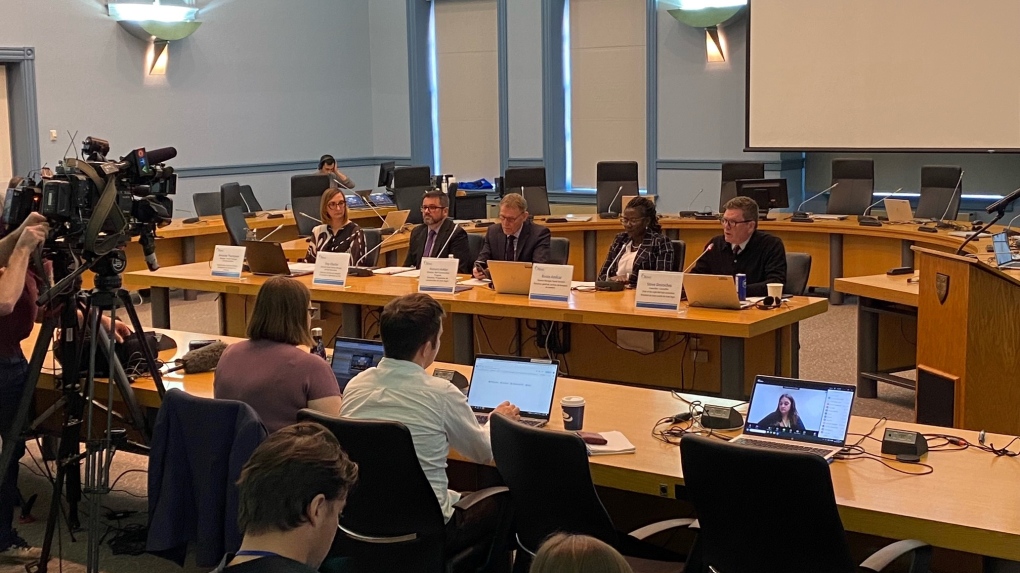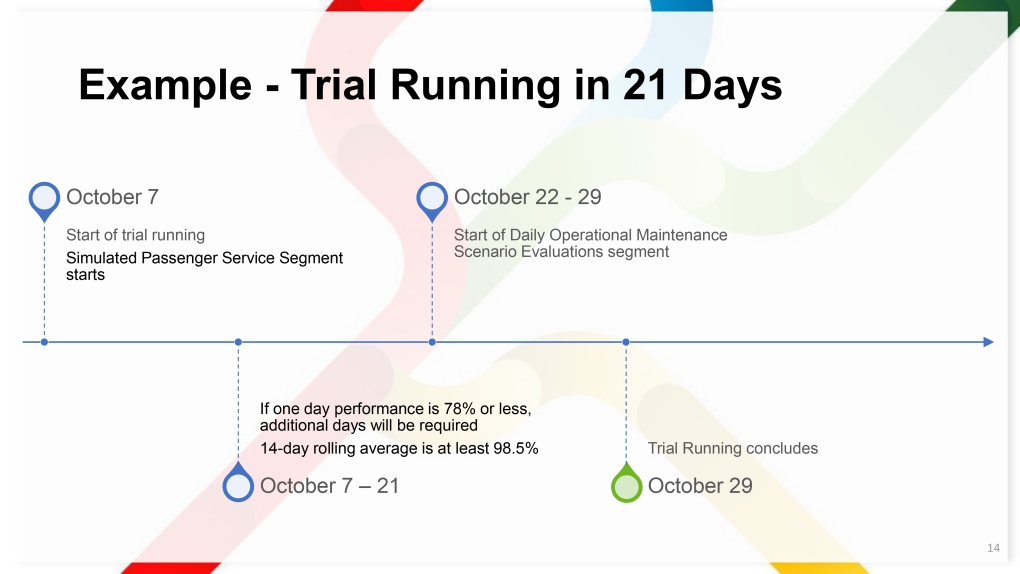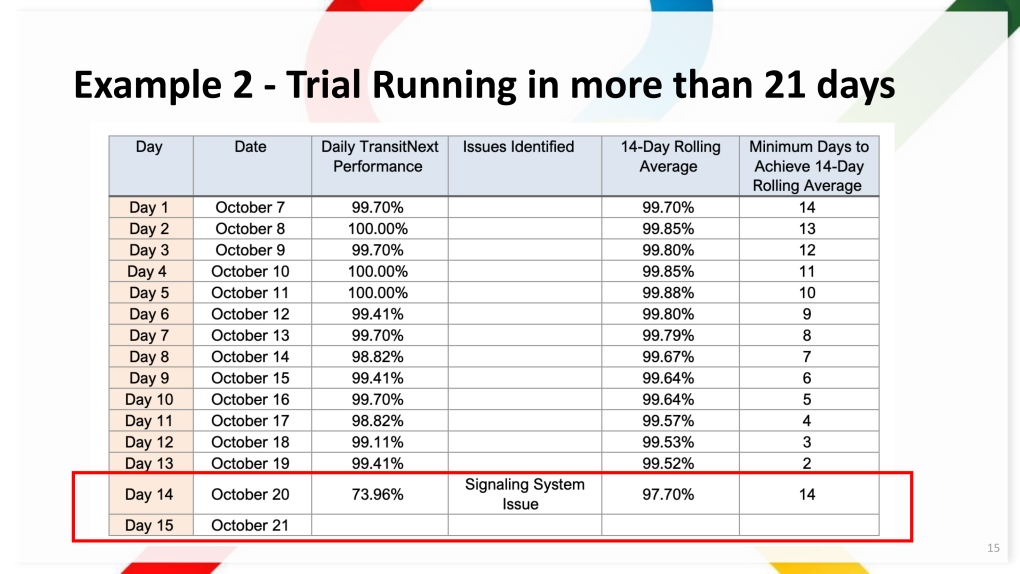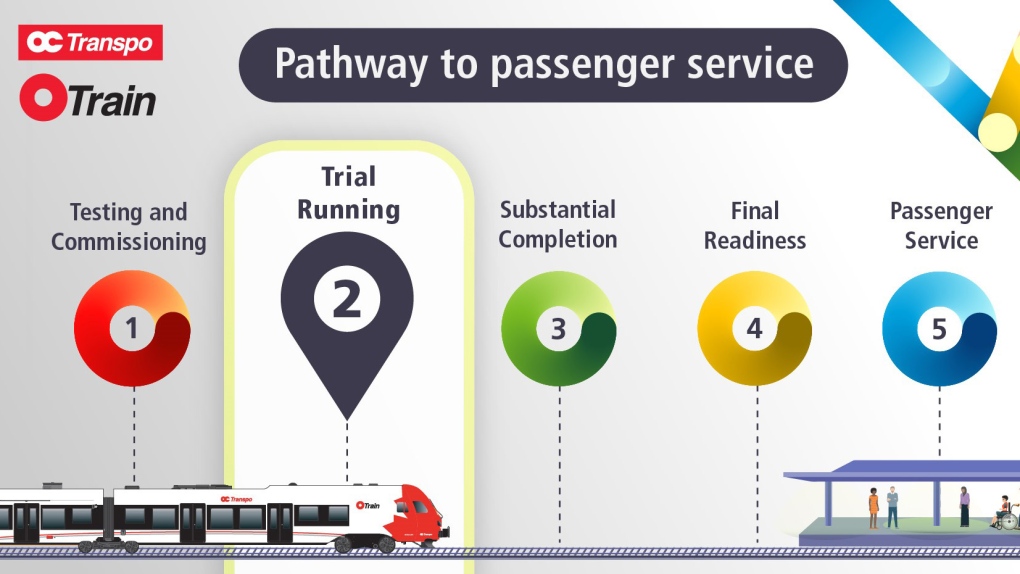Trial running of Trillium Line LRT to begin Oct. 7
The final phase of testing for the much-delayed Trillium Line LRT will begin next week.
Transit Services General Manager Renée Amilcar said Thursday in a technical briefing at Ottawa City Hall that the 21-day trial running period for O-Train Line 2 and Line 4 will begin Oct. 7, meaning the line could open to the public as soon as mid-November.
"TransitNext has spent the last several years preparing for this test. This is TransitNext's final exam, and it will be a rigorous one. TransitNext and OC Transpo have studied hard, have practiced multiple times and we are united in our confidence in the reliability of the system," Amilcar said. "But the proof will be in the daily testing results. Those results alone, which everyone will be able to see, will determine the success of trial running."
 Officials from OC Transpo provide a technical briefing about O-Train Line 2 and 4. Oct. 3, 2024. (Kimberley Fowler/CTV News Ottawa)
Officials from OC Transpo provide a technical briefing about O-Train Line 2 and 4. Oct. 3, 2024. (Kimberley Fowler/CTV News Ottawa)
Trains have been running on the line for months as TransitNext and OC Transpo completed a series of prerequisites required for trial running. In August, staff said two of the nine trial running prerequisites were done. All nine are now complete. These prerequisites include fully testing the entire fleet of light rail vehicles, making sure all stations are substantially complete, ensuring there are no outstanding defects affecting the rail systems, and making sure TransitNext and the City of Ottawa are fully prepared to begin trial running.
Trial running is a minimum 21-day period of testing during which TransitNext, the SNC-Lavalin subsidiary that has designed and built the extension, is tested on on-time performance and ability to react to problem scenarios. It will be divided into two sections, a 14-day on-time performance evaluation and a seven-day maintenance and operations evaluation. It is one of the final phases of testing for the system, which is more than two years behind schedule.
The trains must run the line on a simulated normal public schedule and must achieve a minimum on-time performance level of 98.5 per cent over a 14-day rolling average. If this is not achieved after the first two weeks, this testing period will be extended. Additional days will also be required if, at any point, one-day performance drops to 78 per cent or less.
Testing reports will be submitted to city council and the media daily Monday to Friday and will also be available on OC Transpo's website.
Following that, there will be a seven-day period during which maintenance and operational teams will be tested on scenarios such as door issues, stopped trains, and single-platform service.
There is a minimum three-week window after trial running is successfully completed before the line can open to the public. According to a presentation, trial running would be completed by Oct. 29 if no issues arise. This would mean a possible public launch on or around Nov. 19.
It is important to note the presentation did not include a definitive public launch date for Lines 2 and 4.
The 16-kilometre Trillium Line will run between Bayview Station and Limebank Station, called Line 2, with a 4-km link from South Keys Station to the Ottawa International Airport, called Line 4.
 An example timeline if no significant issues pop up during trial running, showing completion by Oct. 29, 2024. (OC Transpo/handout)
An example timeline if no significant issues pop up during trial running, showing completion by Oct. 29, 2024. (OC Transpo/handout)
How is on-time performance measured?
In order to pass the first phase of trial running, trains must have an on-time performance of 98.5 per cent over a 14-day rolling average.
This metric is measured by assessing the on-time departures at terminus stations for both Line 2 and Line 4, while respecting the required dwell times. Line 2's terminus stations are Bayview and Limebank and Line 4's terminus stations are South Keys and Airport.
Trains must depart within 30 seconds of their scheduled departure time to be considered "on time."
The daily performance will be measured as the number of on-time departures divided by the number of planned departures. These daily metrics will then be divided over the number of days of testing. If, after 14 days, the rolling average remains at or above 98.5 per cent, this phase will be complete.
If an on-time performance of 78 per cent or less is recorded on a particular day, additional testing days will automatically be required.
"We will not be rushing trial running and we will continue until the 98.5 per cent 14-day rolling average as required is achieved," said Richard Holder, Director of Rail Construction.
Holder gave an example of the daily performance dropping to 73 per cent on the final day of testing, bringing the rolling average below 98.5 per cent. In this scenario, trial running would start over and 14 more days of testing would be required.
Staff say the 14-day rolling average is meant to account for daily variations.
 An example of what would happen if there is a substantial failure during trial running, requiring the minimum 14-day testing period to restart. (OC Transpo/handout)
An example of what would happen if there is a substantial failure during trial running, requiring the minimum 14-day testing period to restart. (OC Transpo/handout)
What will the second phase measure?
The second phase of trial running is a daily operational and maintenance scenario evaluation. The objective is for operational and maintenance teams to work through various scenarios that are typically encountered during regular service.
Examples include door issues, stopped trains, issues requiring service on only one platform, or issues that require removing a train from service.
Stuck doors were among some of the first issues that arose on Line 1 in the weeks following its launch in 2019. Line 1 has regular train stoppages for a variety of reasons, which sometimes require single-platform service while the issue is addressed.
Staff say this testing period will allow the maintenance and operations teams to test and verify procedures and identify and address any gaps in those procedures before the system launches.
After seven days, trial running will be considered complete.
This phase does not include a pass-fail metric, Amilcar said.
"The last seven days, it's for us. We are going to play with the system. There is no fail or pass state. If we need to play more with the system, we'll do," she said. "The pass will be for TNext because that's why I said many times it's TNext's exam. OC Transpo will play with the system to make sure that we can mimic everything that will happen to our customers but there is no pass and no fail for the last seven days."
What is needed before the line launches?
After trial running is complete, there is a minimum three-week period to get the line ready for passengers.
This includes certification of substantial completion by an independent certifier, submission by TransitNext of the final engineering and safety assurance case, and a final review of the safety case by the City of Ottawa's independent safety auditor. The line must also be issued a certificate of fitness by the Canadian Transportation Agency and a railway operating certificate by Transport Canada.
Staff will also continue to operate the line and conduct situational drills after the trial running period. This will include a "dress rehearsal" that involves hundreds of volunteers and staff to test how customers navigate and interact with the system.
Provided that no new safety issues or reliability defects arise during the final running period, staff will inform council of a launch date for the line.
 A graphic showing the steps left to take the launch the Trillium Line LRT to the public. Step 2, Trial Running, begins Oct. 7, 2024. (OC Transpo/handout)
A graphic showing the steps left to take the launch the Trillium Line LRT to the public. Step 2, Trial Running, begins Oct. 7, 2024. (OC Transpo/handout)
New Ways to Bus delayed to spring 2025
A major review of OC Transpo's bus routes was slated to come into effect with the launch of the Trillium Line, but Amilcar says that has been delayed to April 2025.
With a possible launch date in mid-November, Amilcar says that would put it close to the Dec. 30 winter seasonal schedule change and she doesn't want to significantly change the bus routes in the winter.
"We don't recommend to launch New Ways to Bus in the middle of the winter for a lot of reasons, good reasons. The first one, it will be winter. Five-thousand stops will be changed. We need to communicate a lot to our customers," she said. "Today, even if it's a good news, I want to be optimistic but realistic — we're not there yet. So, that would mean we would need to prepare now for maybe December 30th. It's not possible."
This means R2 buses, which have been running north and south in place of the Trillium Line, will continue through the winter to offer parallel bus service during the initial launch of the new LRT line. OC Transpo offered parallel bus service to Line 1 for three weeks after its launch.
"New Ways to Bus" includes a major overhaul of dozens of bus routes and thousands of stops.
CTVNews.ca Top Stories

Labour minister pushes for 'deal at the table' after Canada Post union issues strike notice
Labour Minister Steven MacKinnon says the federal government currently has no plans to intervene in negotiations after the union representing Canada Post workers issued a 72-hour strike notice.
What consumers need to know if Canada Post workers strike ahead of a busy holiday season
Canada's postal workers could walk off the job or the company could lock them out as soon as 12:01 a.m. ET Friday if the union and the company don't reach an agreement. Here are tips for shoppers and businesses.
BREAKING Feds move to end work stoppages at ports, order binding arbitration
Labour Minister Steven MacKinnon says he is intervening to end the work stoppages at ports in both British Columbia and Montreal.
23 arrested after at least 100 shots fired in exchange of gunfire outside Toronto recording studio: police
Police say 23 people are in custody after at least 100 shots were fired in an exchange of gunfire outside a West Queen West recording studio on Monday night.
Campaign staffer resigns after N.S. PCs accused of vote-buying with Tim's gift cards
The Nova Scotia Liberal Party has filed a complaint with Elections Nova Scotia, accusing a Progressive Conservative candidate of trying to buy votes by allegedly handing out gift cards outside of a Tim Hortons.
Ottawa high school principal apologizes for song played during Remembrance Day assembly
The principal of an Ottawa high school is apologizing to students, parents and guardians after an Arabic-language song was played during the school's Remembrance Day service.
The Taliban will attend a UN climate conference for the first time
The Taliban will attend a UN climate conference for the first time since their takeover of Afghanistan in 2021, the country's national environment agency said Sunday.
Federal judge blocks Louisiana law that requires classrooms to display Ten Commandments
A new Louisiana requirement that the Ten Commandments be displayed in every public classroom by Jan. 1 was temporarily blocked Tuesday by a federal judge who said the law is 'unconstitutional on its face.'
Northern Ont. suspect sentenced to house arrest five days before vicious attack on ex-girlfriend
The 18-year-old man accused in a vicious attack on his ex-girlfriend in Cobalt last week was sentenced to house arrest five days before the Nov. 3 assault.






























